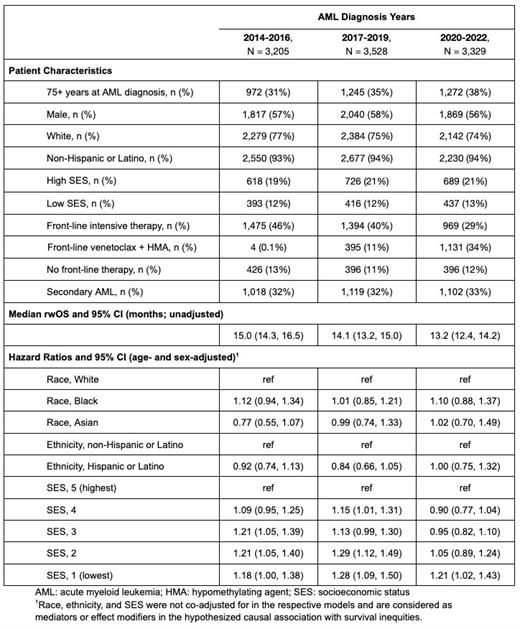Introduction:
There has been considerable growth in the treatment armamentarium of acute myeloid leukemia (AML) in the last decade. However, there is a lack of recent real-world evidence examining trends in survival amidst this rapidly changing treatment landscape. Further, prior literature has demonstrated significant heterogeneity in outcomes across different demographic groups, with scant data to understand how newer therapies have impacted survival outcomes across demographic groups in a real-world setting. The objective of this study is to describe recent trends in overall survival (rwOS) among patients with AML and to examine associations between race, ethnicity, and socioeconomic status (SES) with rwOS over time.
Methods:
We conducted a retrospective cohort study with data from the nationwide Flatiron health (FH) electronic health record-derived de-identified database, which is comprised of predominantly community oncology-based sites. We included patients with ≥2 visits in the FH network with a confirmed diagnosis of AML between Jan 1, 2014 and Dec 31, 2022, with potential follow-up through May 31, 2023. Our exposures included year of diagnosis in 3-year periods (2014-2016, 2017-2019, 2020-2022), race, ethnicity, and area-level SES, as measured using the Yost Index at census block group level. Patient characteristics and treatment patterns were described overall and by time periods of AML diagnosis. The Kaplan-Meier method was used to estimate median rwOS and 95% confidence intervals (CIs) from the time of initial AML diagnosis; overall and stratified by time period of AML diagnosis. Cox proportional hazards models were used to estimate unadjusted and minimally-adjusted (for age and sex) hazard ratios (HR) and 95% CIs for associations between race, ethnicity, and SES (modeled separately) with rwOS overall and by year of AML diagnosis..
Results:
A total of 10,062 patients were included in the analysis. The median (IQR) age at diagnosis was 70 years (58, 78) and 57% of patients were male. Three-fourths of the study population was White, and 70% of the cohort received care at the community oncology clinic. We identified more patients ≥75 years at diagnosis in 2020-2022 versus 2014-2016 (38% vs 31%) and an overall decrease in patients who underwent hematopoietic stem cell transplant (15% vs 21%). Although the overall proportion of patients receiving any first-line treatment was similar across time periods, fewer patients received induction chemotherapy-based regimens (29%) compared to less intensive therapies (e.g., venetoclax + hypomethylating agent; 34%) in later years. There were 6,132 deaths and an overall median rwOS was 14.2 months (95% CI 13.7-14.7). Age and sex-adjusted Cox models indicated no evidence of decreased risk of death for diagnoses in 2020-2022 (HR 0.98, 95% CI 0.92-1.05) or 2017-2019 (HR 0.95, 95% CI 0.90, 1.02) compared to diagnoses in 2014-2016. Adjusted Cox models showed no statistically significant associations between race or ethnicity with survival overall and across strata of AML diagnosis time periods. Consistent associations between the lowest SES and increased risk of overall mortality among patients with AML were observed across all time periods. Patients residing in areas in the lowest quintile of SES had increased risks of death across all three time periods (2014-2016: HR 1.18, 95% CI 1.00-1.38; 2017-2019: HR 1.28, 95% CI 1.09-1.50; 2020-2022: HR 1.21, 95% CI 1.02-1.43).
Conclusion:
Results of this real-world study indicate that persons with AML who are in the lowest SES group are associated with increased mortality risk, and this association persists across recent time periods. Race and ethnicity were not associated with survival in this study, although sample size was limited for some groups. Despite introduction of new therapeutic options and an increased utilization of less intensive therapies, we did not observe an increase in the overall proportion of patients with AML receiving first-line treatment. Additionally, we observed no improvement in survival outcomes across these time periods in a predominantly community-based setting. Our study adds to the growing evidence on the complex health inequities in AML and supports the persistent need for tolerable and accessible therapy to improve OS in AML. Future strategies and policies are urgently needed to offset the adverse effects of low SES to further improve outcomes for all patients with AML.
Disclosures
Guinter:Flatiron Health Inc: Current Employment; Roche: Current equity holder in publicly-traded company. Kerr:Flatiron Health Inc.: Current Employment; Roche: Current equity holder in publicly-traded company. Calip:Roche: Current equity holder in publicly-traded company; Flatiron Health Inc.: Current Employment. Kumar:Flatiron Health Inc.: Current Employment; Roche: Current equity holder in publicly-traded company. Sawas:Flatiron Health Inc.: Current Employment; Seagen: Consultancy, Speakers Bureau; Roche: Current equity holder in publicly-traded company; Acrotech Biopharma: Consultancy, Speakers Bureau; Daiichi Sankyo: Speakers Bureau; Affimed: Research Funding.


This feature is available to Subscribers Only
Sign In or Create an Account Close Modal